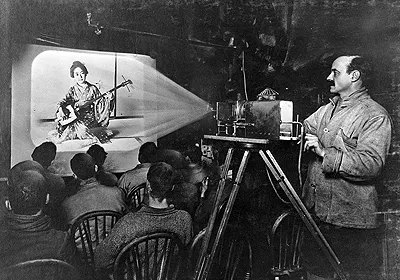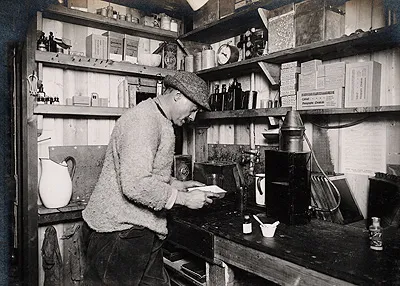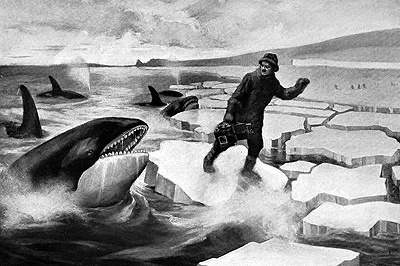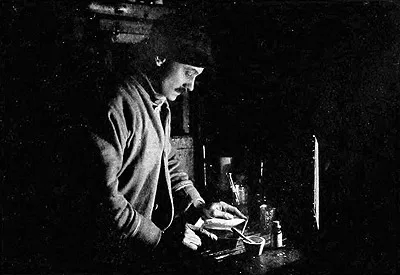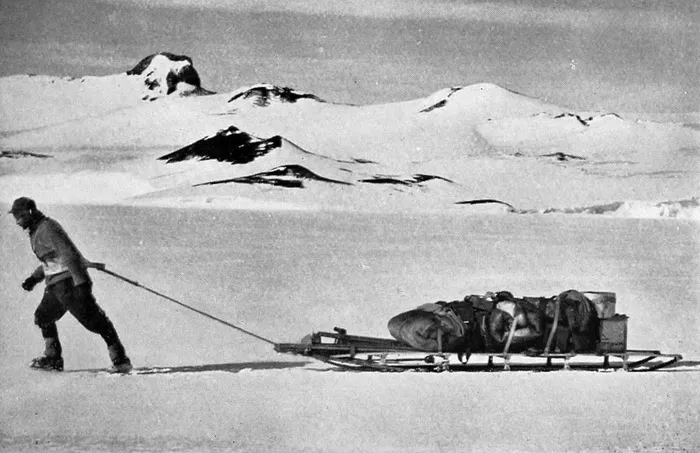Herbert George Ponting - Camera artist
1870 - 1935
- Biographical notes
Photographer Terra Nova 1910-13
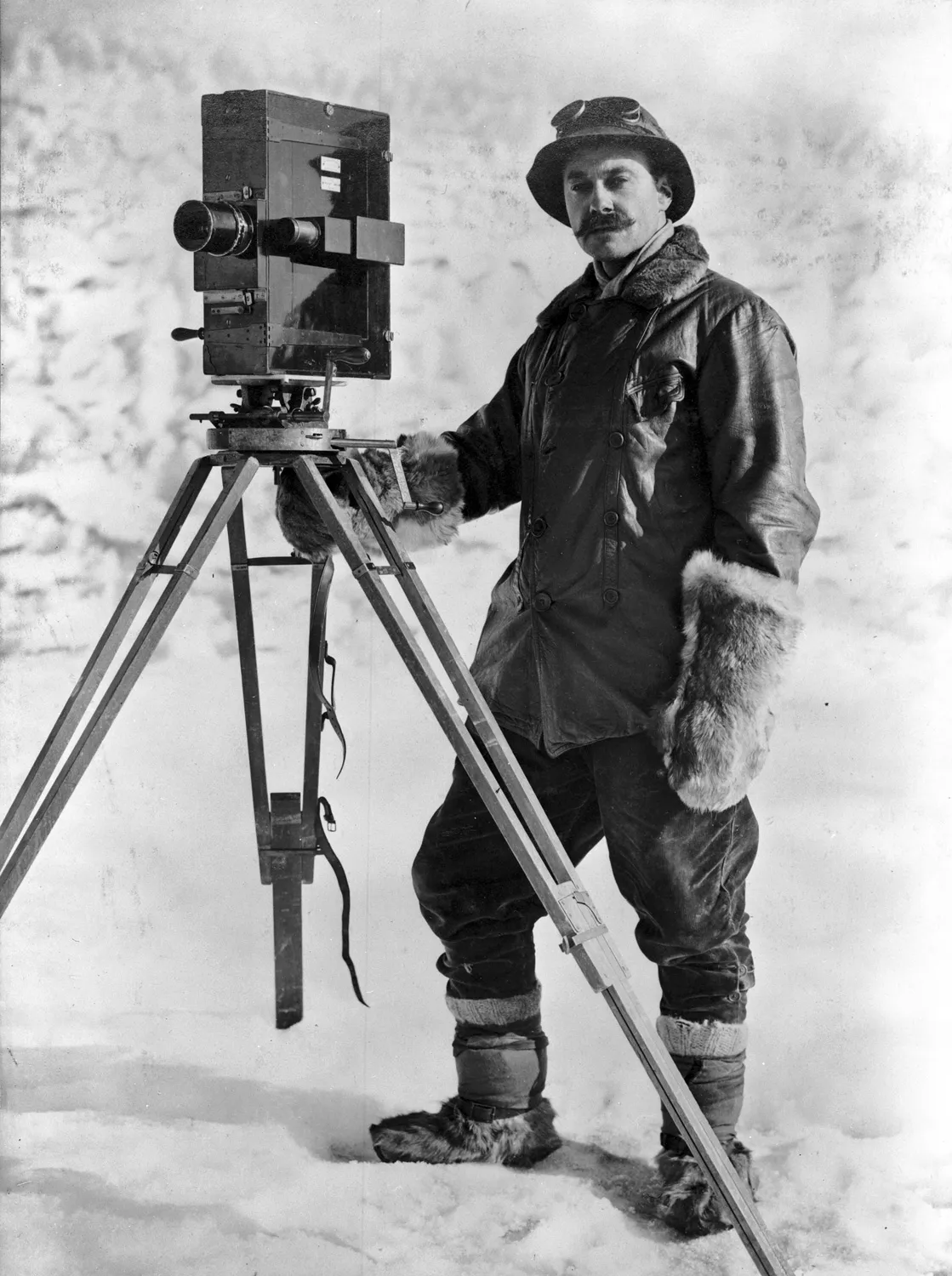
Herbert Ponting
21st March 1870 - 7th February 1935
Born the son of a successful banker in Wiltshire, England, Ponting spent 4 years from the age of 18 following in his father's footsteps before moving to California, first working in mining before owning a fruit ranch until 1898 when he returned briefly to his family in England now having a wife and one year old daughter.
Upon return to California, he turned his long standing hobby of photography into a profession. He built up a sufficient reputation as a photo-journalist that Scott engaged him as expedition photographer on the Terra Nova, the first professional photographer to accompany an Antarctic expedition.
The great majority of the photographs of the Terra Nova Expedition (including most on this and connected pages) were taken by Ponting, he also taught some of the other expedition members how to take photographs. He also took a cine camera and some colour plates at a time when both technologies were in their infancy. He spent 14 months in Antarctica returning in February 1912, a month before Scott and the polar party were to die on the way back from the pole, with over 1,700 photographic plates. Part of his task on returning home was to use his pictures to assemble a narrative of the expedition which Scott would use in a fund-raising lecture tour when he too returned. Ponting's material, both movie and still was intended to help recoup the significant debts of the expedition, and publicize his work widely.
With Scott's death and subsequent public donations, the expeditions debts were paid off and more, so Ponting's pictures became more of an epitaph than a celebration and earned him little money. He produced two films from his material, The Great White Silence (1924 - silent) and Ninety Degrees South (1933 - with sound).
The Scott Polar Research Institute bought the photographs for £533,000 in 2009, some were produced for sale as (very expensive) platinum prints and The Great White Silence was restored and re-released in 2011. Ponting's pictures of Antarctica and Scott's expedition are amongst the finest and most iconic from the Heroic Age of Antarctic exploration.
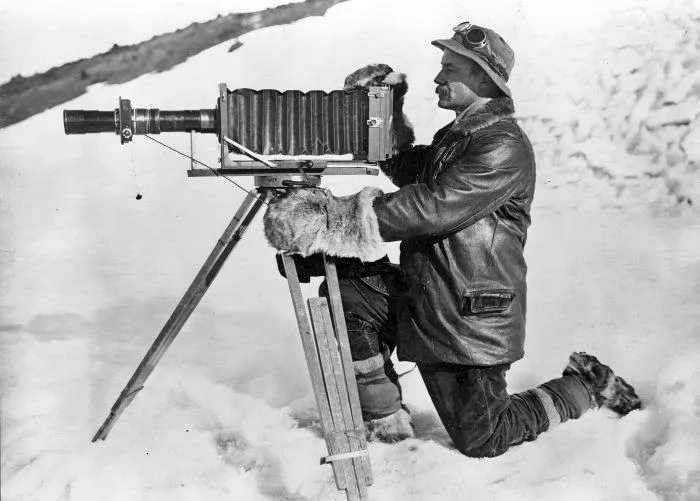
Herbert George Ponting and telephoto apparatus, Antarctica,
January 1912
References to Herbert Ponting by Cherry-Garrard in "The Worst Journey in the World"
-
The Weddell, living on fish, has a more simple group, but these are liable to become very worn in old age, due to his habit of gnawing out holes in the ice for himself, so graphically displayed on Ponting's cinematograph.
-
No officer nor seaman, however, could have had too many of Ponting's lectures, which gave us glimpses into many lands illustrated by his own inimitable slides. Thus we lived every now and then for a short hour in Burmah, India or Japan, in scenes of trees and flowers and feminine charm which were the very antithesis of our present situation, and we were all the better for it. Ponting also illustrated the subjects of other lectures with home-made slides of photographs taken during the autumn or from printed books.
-
Ponting gave a great lecture with slides which he had made since we arrived, many of which Meares had coloured. When one of these came up one of us would shout, "Who coloured that," and another would cry, "Meares," - then uproar. It was impossible for Ponting to speak.
References to Herbert Ponting by Scott in "Scott's Last Expedition"
-
Ponting cannot face meals but sticks to his work; on the way to Port Chalmers I am told that he posed several groups before the cinematograph, though obliged repeatedly to retire to the ship's side. Yesterday he was developing plates with the developing dish in one hand and an ordinary basin in the other!
-
Last night I discussed the Western Geological Party, and explained to Ponting the desirability of his going with it. I had thought he ought to be in charge, as the oldest and most experienced traveller, and mentioned it to him - then to Griffith Taylor. The latter was evidently deeply disappointed. So we three talked the matter out between us, and Ponting at once disclaimed any right, and announced cheerful agreement with Taylor's leadership; it was a satisfactory arrangement, and shows Ponting in a very pleasant light. I'm sure he's a very nice fellow.
-
Some six or seven killer whales, old and young, were skirting the fast floe edge ahead of the ship; they seemed excited and dived rapidly, almost touching the floe. As we watched, they suddenly appeared astern, raising their snouts out of water. I had heard weird stories of these beasts, but had never associated serious danger with them. Close to the water's edge lay the wire stern rope of the ship, and our two Esquimaux dogs were tethered to this. I did not think of connecting the movement of the whales with this fact, and seeing them so close I shouted to Ponting, who was standing abreast of the ship. He seized his camera and ran towards the floe edge to get a close picture of the beasts, which had momentarily disappeared. The next moment the whole floe under him and the dogs heaved up and split into fragments. One could hear the booming noise as the whales rose under the ice and struck it with their backs. Whale after whale rose under the ice, setting it rocking fiercely; luckily Ponting kept his feet and was able to fly to security. By an extraordinary chance also, the splits had been made around and between the dogs, so that neither of them fell into the water. Then it was clear that the whales shared our astonishment, for one after another their huge hideous heads shot vertically into the air through the cracks which they had made. As they reared them to a height of six or eight feet it was possible to see their tawny head markings, their small glistening eyes, and their terrible array of teeth - by far the largest and most terrifying in the world. There cannot be a doubt that they looked up to see what had happened to Ponting and the dogs.
-
Ponting has been ravished yesterday by a view of the ship seen from a big cave in an iceberg, and wished to get pictures of it. He succeeded in getting some splendid plates. This fore-noon I went to the iceberg with him and agreed that I had rarely seen anything more beautiful than this cave. It was really a sort of crevasse in a tilted berg parallel to the original surface; the strata on either side had bent outwards; through the back the sky could be seen through a screen of beautiful icicles - it looked a royal purple, whether by contrast with the blue of the cavern or whether from optical illusion I do not know. Through the larger entrance could be seen, also partly through icicles, the ship, the Western Mountains, and a lilac sky; a wonderfully beautiful picture.
-
Ponting is simply entranced with this view of Mt. Erebus, and with the two bergs in the foreground and some volunteers he works up foregrounds to complete his picture of it.
-
Ponting had an alarming adventure about this time. Bent on getting artistic photographs with striking objects, such as hummocked floes or reflecting water, in the foreground, he used to depart with his own small sledge laden with cameras and cinematograph to journey alone to the grounded icebergs. One morning as he tramped along harnessed to his sledge, his snow glasses clouded with the mist of perspiration, he suddenly felt the ice giving under his feet. He describes the sensation as the worst he ever experienced, and one can well believe it; there was no one near to have lent assistance had he gone through. Instinctively he plunged forward, the ice giving at every step and the sledge dragging through water. Providentially the weak area he had struck was very limited, and in a minute or two he pulled out on a firm surface. He remarked that he was perspiring very freely!
-
Ponting has fitted up his own dark room - doing the carpentering work with extraordinary speed and to everyone's admiration.
-
Before we could get away Ponting had his half-hour photographing us, the ponies and the dog teams - I hope he will have made a good thing of it.
-
Ponting's nervous temperament allowed no waste of time - for him fine weather meant no sleep; he decided that lost opportunities should be as rare as circumstances would permit.
-
Ponting has been making great advances in flashlight work, and has opened up quite a new field in which artistic results can be obtained in the winter.
-
Ponting has been out to the bergs photographing by flashlight. As I passed south of the Island with its whole mass between myself and the photographer I saw the flashes of magnesium light, having all the appearance of lightning. The light illuminated the sky and apparently objects at a great distance from the camera. It is evident that there may be very great possibilities in the use of this light for signalling purposes and I propose to have some experiments.
-
I am glad that the light is coming for more than one reason. The gale and consequent inaction not only affected the ponies, Ponting is not very fit as a consequence - his nervous temperament is of the quality to take this wintering experience badly - Atkinson has some difficulty in persuading him to take exercise - he managed only by dragging him out to his own work, digging holes in the ice.
-
The second weekly lecture was given by Ponting. His store of pictures seems unending and has been an immense source of entertainment to us during the winter. His lectures appeal to all and are fully attended. This time we had pictures of the Great Wall and other stupendous monuments of North China. Ponting always manages to work in detail concerning the manners and customs of the peoples in the countries of his travels; on Friday he told us of Chinese farms and industries, of hawking and other sports, most curious of all, of the pretty amusement of flying pigeons with aeolian whistling pipes attached to their tail feathers.
-
Ponting would have been a great asset to our party if only on account of his lectures, but his value as pictorial recorder of events becomes daily more apparent. No expedition has ever been illustrated so extensively, and the only difficulty will be to select from the countless subjects that have been recorded by his camera--and yet not a single subject is treated with haste; the first picture is rarely counted good enough, and in some cases five or six plates are exposed before our very critical artist is satisfied.
-
I am determined to make some better show of our photographic work on the Southern trip than has yet been accomplished--with Ponting as a teacher it should be easy. He is prepared to take any pains to ensure good results, not only with his own work but with that of others--showing indeed what a very good chap he is.
-
Ponting has been doing some wonderfully fine cinematograph work. My incursion into photography has brought me in close touch with him and I realise what a very good fellow he is; no pains are too great for him to take to help and instruct others, whilst his enthusiasm for his own work is unlimited.
His results are wonderfully good, and if he is able to carry out the whole of his programme, we shall have a cinematograph and photographic record which will be absolutely new in expeditionary work. -
The photography craze is in full swing. Ponting's mastery is ever more impressive, and his pupils improve day by day; nearly all of us have produced good negatives. Debenham and Wright are the most promising, but Taylor, Bowers and I are also getting the hang of the tricky exposures.
-
I posted out over the land and found Ponting much distressed and Clissold practically insensible. At this moment the Hut Point ponies were approaching and I ran over to intercept one in case of necessity. But the man party was on the spot first, and after putting the patient in a sleeping-bag, quickly brought him home to the hut. It appears that Clissold was acting as Ponting's 'model' and that the two had been climbing about the berg to get pictures. As far as I can make out Ponting did his best to keep Clissold in safety by lending him his crampons and ice axe, but the latter seems to have missed his footing after one of his 'poses'; he slid over a rounded surface of ice for some 12 feet, then dropped 6 feet on to a sharp angle in the wall of the berg.
Landmarks named after Herbert Ponting
Feature Name:
Ponting Cliff
Type: cliff
Latitude:
71°12'S
Longitude: 168°21'E
Description: An angular cliff that is similar
in appearance to Meares Cliff just eastward, located 3 mi E
of the terminal confluences of the Dennistoun, Nash and Wallis
Glaciers on the northern coast of Victoria Land. First charted
by the Northern Party, led by Campbell, of the British Antarctic
Expedition (BrAE), 1910-13.
Other Crew of the Terra Nova Expedition
Abbot,
George Percy - Petty Officer, R.N. - 1, 2, N
Atkinson, Edward
L. - R.N. - surgeon, parasitologist - 1, 2, D, P, S
Balson,
Albert - Leading seaman, R.N.- 1, 2
Bowers,
Henry Robertson - Lieutenant - 1, 2, D, C,
Po
Browning,
Frank Vernon - Petty Officer - 1, 2, N
Campbell,
Victor - Lieutenant, R.N. - 1, 2, N
Cheetham,
Alfred B. - Boatswain (Bosun), R.N.R.
Cherry-Garrard,
Apsley - Assistant zoologist - 1, 2, D, C, S
Crean,
Tom - petty officer, R.N. - 1, 2, D, P, S
Debenham, Frank
- Geologist - 1, 2, iW, iiW
Dickason,
Harry - Able Seaman - 1, 2, N
Evans, Edgar - petty
officer, R.N. - 1, iW, Po
Evans, Edward R.G.R. - Lieutenant, R.N. "Teddy Evans" -
second in command, and Captain of the Terra Nova - 1, D, P
Girev
(Geroff), Dmitriy - Dog driver - 1, 2, D, P, S
Gran,
Tryggve - ski expert - 1, 2, D, iiW, S
Lashly, William
- chief stoker, R.N. - 1, 2, P, S
Levick,
G. Murray - Surgeon, R.N. - 1, 2, N
Lillie, Dennis Gascoigne - Biologist
on the ship
McLeod, Thomas
F. - Able seaman - 1, 2
Meares, Cecil
H. - in charge of dogs - 1, D, P
Oates, Lawrence
- Capt. 6th Iniskilling Dragoons - 1, D,
Po
Ponting,
Herbert G. - Camera artist - 1
Priestley,
Raymond E. - Geologist - 1, 2, N
Omelchenko,
Anton - Groom - 1
Scott, Robert
Falcon - Commander, R.N. -
Expedition leader - 1, D, Po
Simpson,
George - Meteorologist - 1
Taylor,
T. Griffith - Geologist - 1, iW, iiW
Wilson,
Edward Adrian - chief of scientific staff and biologist - 1, D, C,
Po
Wright,
Charles Seymour - Physicist - 1, 2, iW, P, S
Key:
1 - first winter
2 - second winter
iW - first western party
iiW - second western party
N - northern
party
D - depot laying for south pole journey
P - south pole party
C - winter journey to Cape Crozier
S - search party for south Pole
party
Po - reached
South Pole
Biographical information
- I am concentrating on the Polar experiences of the men involved.
Any further information or pictures visitors may have will be gratefully received.
Please email
- Paul Ward, webmaster.
What are the chances that my ancestor was an unsung part of the Heroic Age
of Antarctic Exploration?

